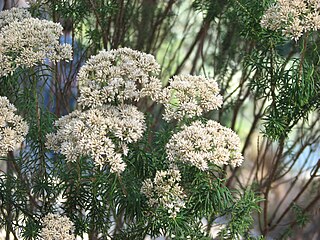
Cassinia is the journal of the Delaware Valley Ornithological Club (DVOC). The journal is composed of papers relating to the ornithology of eastern Pennsylvania, New Jersey, and Delaware. Seventy three issues have been published to date. Five initial volumes (1890–1900) were published under the name Abstract of the Proceedings of the Delaware Valley Ornithological Club, and then in 1901 the journal was renamed in honor of ornithologist John Cassin.

Cassinia is a large genus of plants in the family Asteraceae, most or all of which are native to the Southern Hemisphere. It was named for French botanist Alexandre de Cassini.
Major Plains is a rural locality situated to the north-west of Benalla in Victoria, Australia. It is 226 kilometres by road from Melbourne.

Galangin is a flavonol, a type of flavonoid.

Cassinia aculeata, also known as common cassinia, dolly bush or dogwood, is a shrub in the family Asteraceae. The species is native to the states of South Australia, New South Wales, Victoria and Tasmania in Australia. It grows to between 1 and 2.5 metres high and has sticky, hair-covered leaves which are 10 to 30 mm long and 1 to 2 mm wide. The creamy-white flower heads appear in dense clusters from summer to autumn.

Cassinia arcuata, commonly known as drooping cassinia, biddy bush, Chinese scrub, Chinese shrub, Sifton bush and tear shrub, is a shrub species in the family Asteraceae. It is endemic to southern Australia. It grows to 2 metres high and has sticky leaves which are 40 to 15 mm long and 1.5 mm wide. The pale brown inflorescences appear in panicles from spring to autumn. Plants have a distinctive curry scent. The species colonises disturbed and cleared sites. It is native to the states of Western Australia, South Australia, New South Wales, and Victoria.

The Burrinjuck Nature Reserve is a protected nature reserve on the south west slopes of New South Wales, Australia. The 5,250-hectare (13,000-acre) reserve is located adjacent to the Burrinjuck Dam, with 5,118 hectares of the reserve located on the northern side of the reservoir, and the remaining 89 hectares located on the southern side of the reservoir to the northeast of Black Andrew Nature Reserve. It includes land formerly managed as the Burrinjuck State Forest and Burrinjuck State Recreation Area.

The Black Andrew Nature Reserve is a protected nature reserve located on the south west slopes of New South Wales, Australia. The 1,559-hectare (3,850-acre) reserve is situated on the southern shore of Burrinjuck Dam on the Murrumbidgee River, an important reservoir for the Murrumbidgee Irrigation Area.

Cassinia laevis, commonly known as cough bush or dead finish, is a plant native to eastern Australia.
Cassinia leptocephala is a plant native to northern New South Wales in eastern Australia.
Cassinia uncata, commonly known as sticky cassinia, is a plant native to eastern Australia.
Cassinia quinquefaria is a plant native to eastern Australia.

Cassinia longifolia is a plant native to eastern Australia.
Cassinia decipiens is a plant native to central New South Wales in eastern Australia.
Cassinia hewsoniae is a plant native to central New South Wales in eastern Australia.
Cassinia monticola is a plant native to far southern New South Wales and Victoria in eastern Australia.
Cassinia ochracea is a plant native to far southern New South Wales in eastern Australia.
Cassinia telfordii is a plant native to central-northern New South Wales in eastern Australia.
Cassinia straminea is a plant native to northern New South Wales in eastern Australia.
Cassinia theresae is a plant native to central-western New South Wales in eastern Australia.








